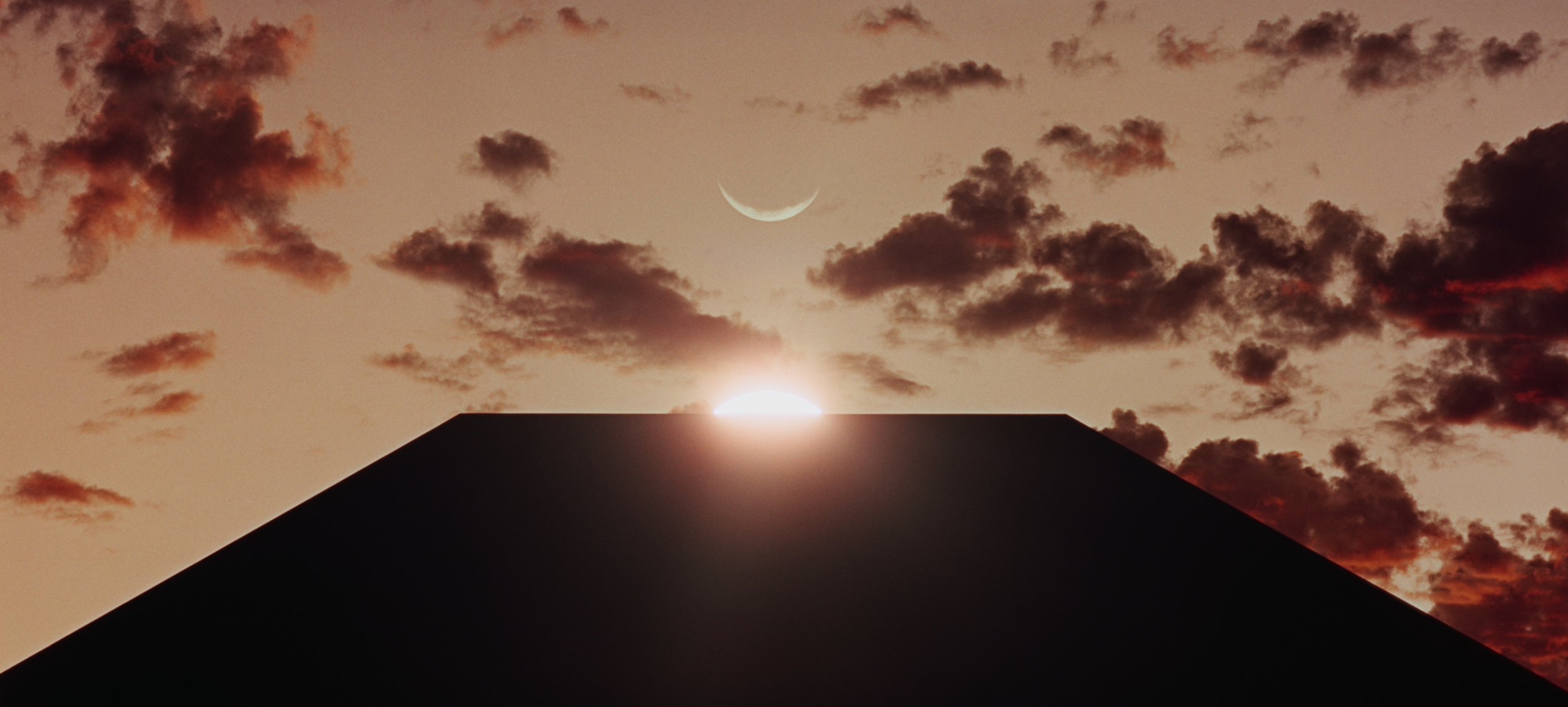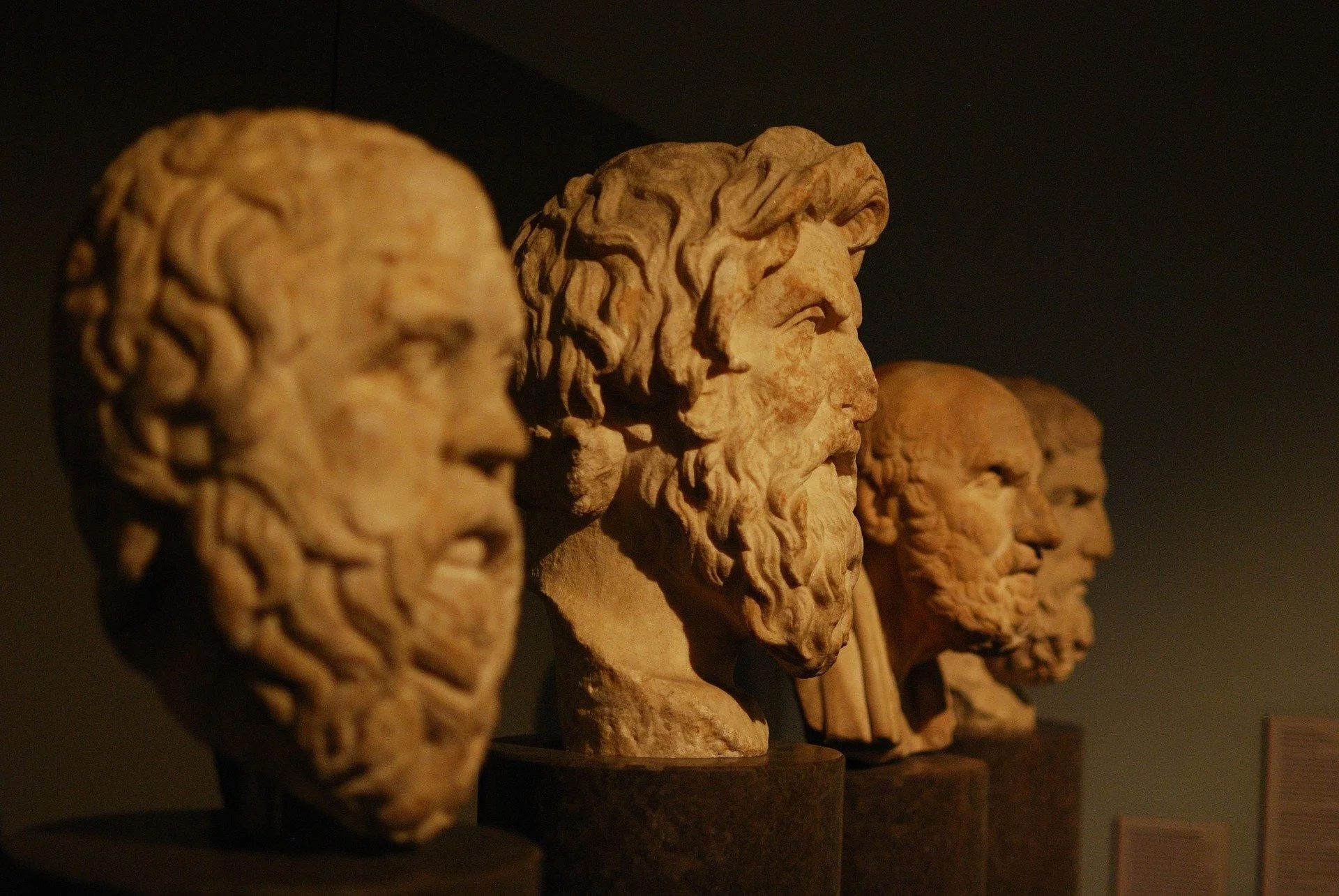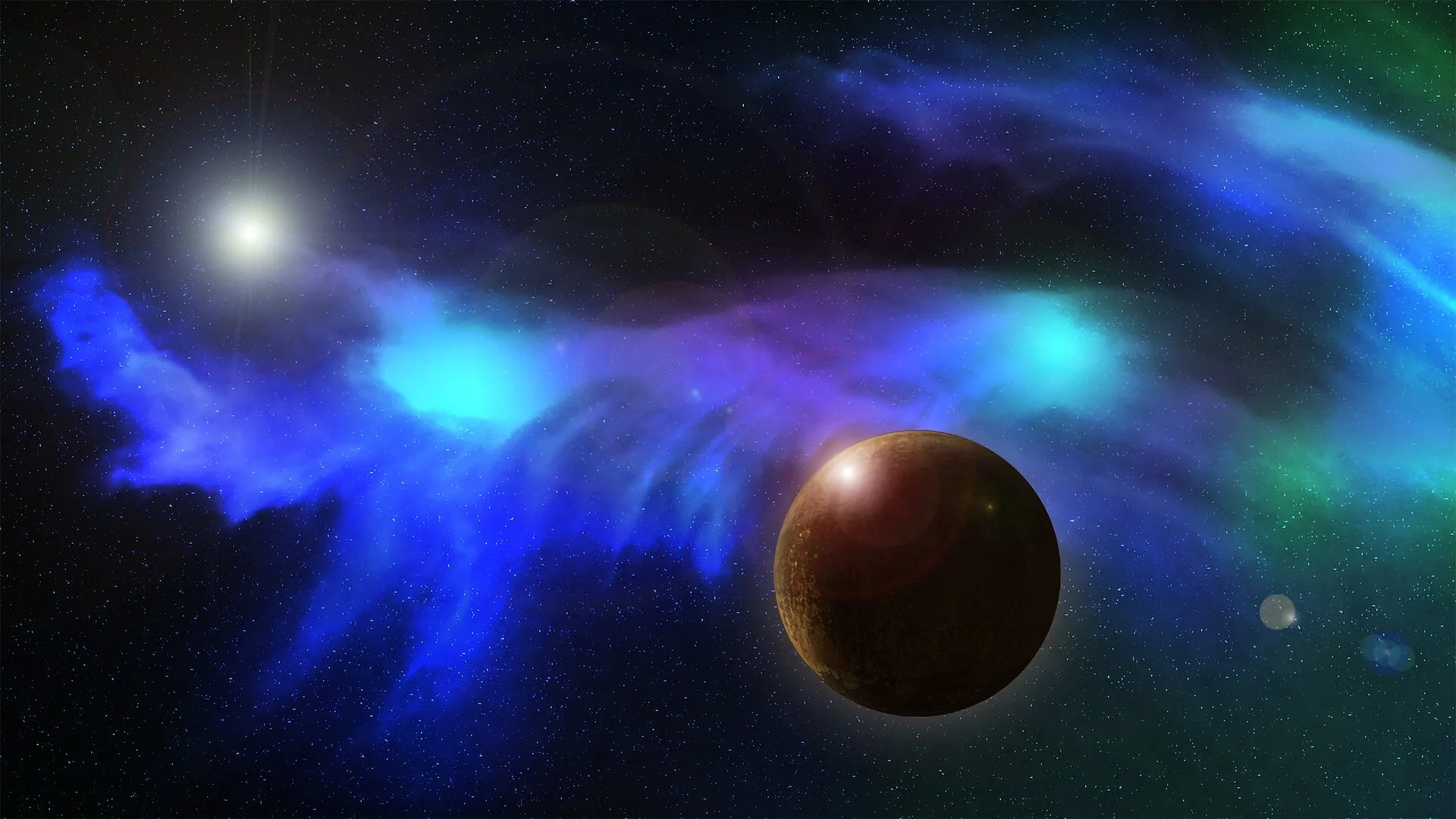2001: A Space Odyssey: A Thoroughly Nietzschean Film
I’ve always been a fan of 2001: A Space Odyssey, both the book and its sequels by Arthur C. Clarke and the well-known Stanley Kubrick film of the same name. As I was rewatching the film recently, and seeing as how I’ve been thinking and writing more about Friedrich Nietzsche, both his philosophical writing and his poetry, I found myself making numerous connections between 2001: A Space Odyssey and Nietzsche, eventually coming to interpret 2001: A Space Odyssey as a thoroughly Nietzschean film.
The obvious connection, and the one most often made, between 2001: A Space Odyssey and Friedrich Nietzsche is the title of the theme music from the film, the opening fanfare to Also Sprach Zarathustra by Richard Strauss, which was inspired by Nietzsche’s similarly titled novel Thus Spoke Zarathustra. The connection here is an obvious one, and fully intentional on the part of director Stanley Kubrick. But I want now to delve deeper than this into the philosophical connections between the content of 2001: A Space Odyssey and Nietzsche’s overall philosophy.
(2001: A Space Odyssey, The Dawn of Man)
In the opening sequence of the film, “The Dawn of Man,” we see a leap in the evolution of protohuman hominids, a spark of intelligence symbolized and expressed by the use of bones as tools, presumably caused by the influence of the black Monolith alien artifact. Although 2001: A Space Odyssey relies heavily on a Darwinian view of human evolution, it is worth noting that Nietzsche himself was a reader and a fan of Charles Darwin’s work on natural selection and the theory of evolution, and many passages of Nietzsche’s own work were inspired by this Darwinian view, such as the following passage from Nietzsche’s essay “On Truth and Lies in a Nonmoral Sense”:
Once upon a time, in some out of the way corner of that universe which is dispersed into numberless twinkling solar systems, there was a star upon which clever beasts invented knowing. That was the most arrogant and mendacious minute of "world history," but nevertheless, it was only a minute. After nature had drawn a few breaths, the star cooled and congealed, and the clever beasts had to die. (Nietzsche, “On Truth and Lies in a Nonmoral Sense,” Philosophy and Truth: Selections from Nietzsche’s Notebooks of the Early 1870’s)
In 2001: A Space Odyssey, we get the chance to see something approximating Nietzsche’s vision of the evolution of humans as “clever beasts,” albeit with a science fiction twist from Arthur C. Clarke, since in the story it’s the monolith that provides the spark of intelligence, not the end result of natural selection as it was for Darwin. An interesting side note is the fact that the opening sequence of 2001: A Space Odyssey is also an excellent depiction of the State of Nature according to Thomas Hobbes, who described man’s natural state as “solitary, poor, nasty, brutish, and short” (Hobbes, Leviathan) which describes very well the life of the protohuman hominids in the film, specifically warring factions competing for basic needs like water and food in the ancient African desert. Nietzsche also makes clear the link between intelligence and survival subsequently in “On Truth and Lies in a Nonmoral Sense”:
And just as every porter wants to have an admirer, so even the proudest of men, the philosopher, supposes that he sees on all sides the eyes of the universe telescopically focused upon his action and thought. It is remarkable that this was brought about by the intellect, which was certainly allotted to these most unfortunate, delicate, and ephemeral beings merely as a device for detaining them a minute within existence. (Nietzsche, “On Truth and Lies in a Nonmoral Sense,” Philosophy and Truth: Selections from Nietzsche’s Notebooks of the Early 1870’s)
Nietzsche makes a similar point about the evolutionary history of human consciousness (and intelligence, by extension) in the opening sentence of Section 11 of The Gay Science:
Consciousness is the latest development of the organic, and hence also its most unfinished and unrobust feature. (Nietzsche, The Gay Science, Section 11)
This passage by Nietzsche is deceptive in its simplicity. In fact, one can discern a fair amount of Nietzsche’s overall philosophy from this sentence alone, just as 2001: A Space Odyssey, in some sense is an encapsulation of Nietzsche’s view of human nature and human potential. According to Nietzsche, our consciousness evolved as a way of keeping ourselves alive in a natural world that is fundamental harsh.
While the emergence of consciousness carried a certain evolutionary advantage, the mistake that Western philosophers have made, from Socrates and Plato onward, and culminating in the Enlightenment philosophers views about the nature of human reason, is to view human consciousness as what Nietzsche pejoratively calls “the kernel of man,” mistakenly believing that consciousness and modern humanity are the pinnacle of the evolutionary process, when in reality consciousness is late-coming in the history of the natural world and a quirk of natural evolution, still in the process of developing. In other words, modern humans, consciousness and all, are still in the process of evolving and developing, both biologically and culturally, and it’s a mistake to view our current human achievements, either psychological or technological, as the peak of human potential or cultural evolution.
(21st-century Spacefaring Human Culture in 2001: A Space Odyssey)
The rather abrupt transition between the opening scene of 2001: A Space Odyssey and the jump cut to 21st-century spacefaring human culture emphasizes this evolutionary link between consciousness and human potential, although it’s clear from the context of the remainder of the film, particularly the “Space Baby” sequence at the conclusion of the film, that humans are not done evolving. Until the end of the film, it would be easy to assume, as Western philosophy, religion, and culture have done since the Enlightenment and into the 20th century, that our contemporary human culture is the pinnacle of humanity, the apex of all creation. By the end of the film, however, it’s clear that Dave Bowman, in his final depiction as an embryo, is a metaphor for all of humanity, that we are actually still in our infancy with untold human potential and future evolution yet to be realized.
This view of humanity, (1) that we have an evolutionary history, and (2) that we still have a long way yet to go, is harmonious with Nietzsche’s hypothetical Übermensch, a future philosopher who will be able to transcend the weaker, herd-like parts of Western culture, religion, and philosophy, a fully realized human being who is not dependent on science, objectivity, or any universal view of human nature to define him- or herself.
We contemporary humans tend to think of science, technology, and the political advances of the Enlightenment period (usually culminating in a democratic society like the United State of America, naturally) as genuine advances. But, in reality, according to Nietzsche and according to Arthur C. Clarke in 2001: A Space Odyssey, these are intermediate stages of development still to be overcome for the sake of realizing our full human potential as individuals, both in our strength of character and in authentic and artistic forms of self-expression.
From the perspective of future, more evolved humanity, our petty political and social concerns of the 21st century will seem as the protohuman hominids in 2001: A Space Odyssey now seem to us: primitive—a theme more fully developed in the sequel novel, 2010: Odyssey Two, and its corresponding film, 2010: The Year We Make Contact, with humanity on the brink of World War III but appearing petty and childish from the perspective of those aboard the Leonov spacecraft millions of miles away in orbit of the planet Jupiter.
(The HAL 9000 Computer in 2001: A Space Odyssey, representing the full realization of human reason and its weaknesses still to be overcome.)
Naturally, in 2001: A Space Odyssey, mankind’s highest technological achievement, the self-aware hyper-intelligent HAL 9000 computer, views itself as superior to humans in every way, no matter how much HAL may enjoy talking to and playing chess with his (inferior) human companions. Naturally, however, this symbol of perfect logical reasoning, HAL, begins to lose his rationality in the film, thus symbolizing the way in which human reasoning, consciousness, human logic are still fundamentally flawed, or at least underdeveloped, from Nietzsche’s perspective.
Although it would be tempting to interpret the mental deterioration of HAL in 2001: A Space Odyssey as symbolic of a type of neo-Luddite technophobia, I instead prefer to interpret HAL as a symbol of humankind’s current evolutionary stage, a natural consequence of the development of human reasoning and consciousness but still something fundamentally flawed and to be transcended in later evolutionary stages. The shift in emphasis from HAL as the focus in the middle of the film to the evolutionary leaps of humanity symbolized by the various depictions of the aging Dave Bowman in the final act of the film make it clear that our modern technological society is not the final stage of humanity’s evolutionary process, a view of humanity that is thoroughly Nietzschean in character.
Much has been written about various interpretations of the final sequence of the film. And although I have described the final “Space Baby” sequence as a metaphor for the future development of humanity yet to come, in the style of Nietzsche’s Übermensch or future philosophers, it’s worth noting that one could also interpret the final sequence of 2001: A Space Odyssey from a Heideggarian standpoint. When Dave Bowman steps outside his space pod and into the Victorian-era environment presumably generated by the alien intelligence responsible for the creation of the Monolith, Bowman begins seeing older versions of himself, like snapshots of his future lifetime laid out before him. At each iteration, however, after seeing his older self, Bowman’s perspective shifts and he becomes the older version of himself from the first-person point of view, abruptly shifting from the third-person point of view held by the younger versions of himself.
(Older Dave Bowman in 2001: A Space Odyssey, symbolizing the way humans project themselves into the future, seeing their own future possibilities and potential)
According to Martin Heidegger, we humans (what Heidegger calls “Dasein,” or “being there” in his book Being and Time) constantly project ourselves into the future, envisioning and projecting possibilities for ourselves and our future from the perspective, possibilities, and sometimes constraints of the present. Before we know it, however, time passes and we actually become the older versions of ourselves that we could only envision for ourselves and project onto ourselves when we are younger. Of course, the struggle of human life is to work to actually achieve what we envision for ourselves in terms of our potential and future possibilities, given the many obstacles we encounter along the way in the course of a human lifetime.
To bring the discussion back to Nietzsche, this struggle to achieve our full potential is harmonious with much of what Nietzsche has to say about human potential and the struggle to achieve that potential, either from the perspective of a single individual or from the perspective of humanity as a whole. We see the metaphorical mountaintops symbolizing the things we might achieve, and we can either stay safely in the lowlands of our comfort zones or put one foot in front of the other and begin our climb up the mountain, regardless of what obstacles we may face along the way. The following examples of Nietzsche’s short poems make clear this burden and drive to achieve our human potential, finding the strength to carry on when other, weaker individuals might give up and retreat to safer ground:
Worldly Wisdom
Stay not where the lowlands are!
Climb not into the sky!
The world looks best by far
when viewed from halfway high.Upward
‘How do I best get to the top of this hill?’
’Climb it, don’t think it, and maybe you will.’My Happiness
Since I grew weary of the search
I taught myself to find instead.
Since cross winds caused my ship to lurch
I sail with all winds straight ahead.(Nietzsche, The Gay Science, ‘Joke, Cunning, and Revenge’: Prelude in German Rhymes)
From the perspective of 2001: A Space Odyssey, with Nietzsche as inspiration and fully in mind, it is most important we humans don’t turn their back on our future human potential and retreat into the lowlands and their safety zones out of fear, as the protohuman hominids are first seen huddling in their caves in the opening sequence of the film. From the perspective of contemporary humanity, humans often fail to look to the future and upward to their potential, either to the mountaintops, as Nietzsche described it, or to the stars as Arthur C. Clarke and Stanley Kubrick allegorically depict that potential.
Humans can remain focused on the concerns of the present, whether political, social, or technological, but in doing so they can lose sight of the ways in which humanity still needs improving while patting themselves on the back with hubris because of their present achievements, just as medieval theologians and their modern philosophical inheritors patted themselves on the back in viewing humanity as the pinnacle of creation with our rationality, our consciousness, and our intelligence of which Nietzsche is so critical in his view of humanity as still quite young and in need of further development.
(The “Space Baby” in 2001: A Space Odyssey represents future human evolution and potential, and the fact that we still have a long way to go as a species.)
Nietzsche’s view of humanity is often taken to be rather dark and nihilistic. This interpretation of Nietzsche’s philosophy, however, doesn’t do justice to the positive vision of human potential about which Nietzsche is so passionate throughout his writing. This Nietzschean optimism for human potential comes through loud and clear in 2001: A Space Odyssey. Human parents usually look at their own children with great optimism, from birth onward, seeing the innate and unrealized potential of the next generation, both as individual people in the making and societally in the improvement of the overall human condition from generation to generation. 2001: A Space Odyssey likewise leaves us with this feeling of optimism about the future of humanity and our human potential with the depiction of the embryonic Space Baby, symbolizing future human potential, overlooking all of planet Earth and with the inspirational fanfare of Also Sprach Zarathustra comprising the final and immersive denouement of the film.
All in all, even if you have never read a word of Friedrich Nietzsche’s philosophical writing, you can get a fairly complete picture of Nietzsche’s overall worldview if you take to heart the metaphorical depictions of humanity in 2001: A Space Odyssey: its depiction of the evolutionary history of humanity, its depiction of HAL as representative of both the achievements and the weaknesses of Western rationality and our present technological age, and Dave Bowman and his final evolutionary leap into the Space Baby as representative of a positive vision of humanity’s future and our potential beyond our present form and achievements.
Nietzsche’s emphasis on the strength of the individual, however, including the individual’s drive toward artistic self-expression, are rather harder to locate within 2001: A Space Odyssey. But even these can be found in the fact that Dave Bowman sees not just humanity but himself from the third-person point of view and all of his own first-person future potential in his visions of his future self in the final act of the film.
All of this is to say that 2001: A Space Odyssey is a thoroughly Nietzschean film through and through, not merely accidentally but fully intentionally on the part of Arthur C. Clarke and Stanley Kubrick. In fact, Nietzsche himself would love the notion that it took an artistic endeavor like the creation of a film so prized for its aesthetic achievements and distinctiveness to bring the fullness of his own philosophy and his positive vision of future human potential to life for the masses, whether or not they ever read a word of Nietzsche’s own writings or have a “philosophical” understanding of Nietzsche or his writings. Nietzsche’s words and his writings were never the point.
Human potential is the underlying theme of Nietzsche’s entire body of work, from beginning to end, and nothing would have made Nietzsche happier than to see an artistic interpretation of his overall message inspiring people to look to their own fullest potential, to the future potential of the human race as a whole, and to the future of humanity beyond the present age and the present stage of human development.



















